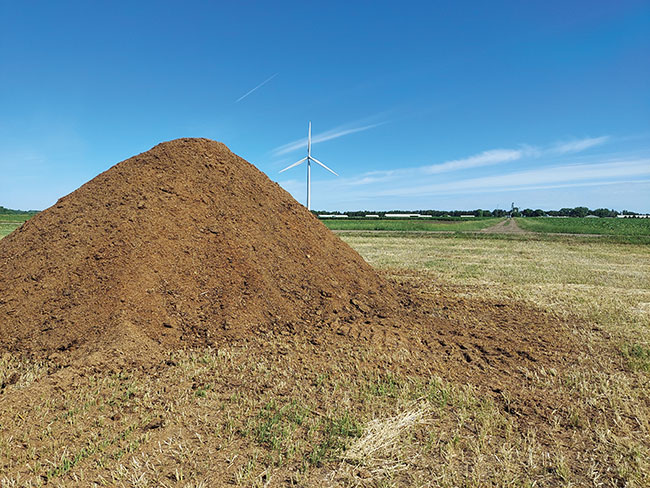
News
Manure Minute
MANURE MINUTE: Manure stockpile siting and sizing
July 19, 2023 by Chryseid Modderman, University of Minnesota Extension
 The ideal stockpile location is in a flat area and out of the way.
Image courtesy of Chryseis Modderman
The ideal stockpile location is in a flat area and out of the way.
Image courtesy of Chryseis Modderman On-farm manure stockpiling doesn’t need to be complicated, but there are a few important things to keep in mind.
Stockpile site selection
As in real estate, it’s all about location, location, location. The ideal stockpile location is out of the way, can be accessed with hauling equipment, and will not lead to runoff into sensitive features.
A flat area, outside of areas that flood, with a non-permeable base to avoid leaching is best. Also, try to be considerate of your down-wind neighbors; a colleague recently told me his neighbor is building a “Mt. Vesuvius of Crap” too close to his house.
Clean water from rain, roofs, or uphill areas should not be allowed to pool around or run through a manure stockpile because any water that comes in contact with the manure will carry away pollutants. Soil berms may be built to divert rain and uphill water, and gutters and downspouts can be added to barns and buildings to divert water.
Storage sizing
Once you have the perfect location picked out, it’s time to think about what the storage area will look like. First, to determine how much space is needed, ask yourself the following questions:
- How many animals will contribute to the manure stockpile?
- How much, and what kind of bedding will be in the manure?
- How long will the stockpile remain before being hauled away?
Let’s say you’re a horse owner. With manure and bedding, a 1000 lb. horse can produce 60 to 70 lbs. of waste per day, occupying around 2.4 cubic feet.
Say you have five horses that each weigh 1,100 pounds. That’s 5,500 pounds total (5 x 1,100). And you haul away your manure twice per year, once in the spring and again in the fall.
You know that an average of 2.4 cubic feet of manure is produced each day per 1000-pound horse. So how much space will you need for manure storage?
2.4 cubic ft x (5500 lb / 1000 lb) x 365 days = 4,818 cubic ft per year
But, you haul manure twice per year, so you really only need storage for half of a year (182.5 days).
2.4 cubic ft x (5500 lb / 1000 lb) x 182.5 days = 2,409 cubic ft needed.
So does that mean you should build a storage pad that is exactly 2,409 cubic feet? No.
These calculations were based on averages to give you an idea of the size needed.
Actual space allotted for storage should be larger than the calculated value to account for variability.
For one, you will likely not haul the manure away at exactly 182.5 days, and you need to ensure that you’ll have enough storage if it is a long winter.
And the actual manure and soiled bedding might vary based on the horse or bedding type.
It’s always best to err on the side of having too much space for manure, rather than cutting it close. That way, if you change bedding or add animals, you won’t need to expand your storage size. •